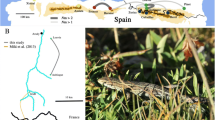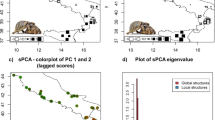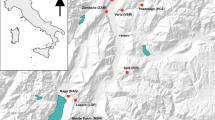Abstract
The golden eagle (Aquila chrysaetos) was once widely distributed in the uplands of the British Isles, but is now extinct in Ireland, and largely confined to the highlands and islands of Scotland. As the precise extent and severity of the reduction in population size are unclear, it is important to understand how the population was affected by the decline. We therefore genotyped 13 polymorphic microsatellite loci in 172 individuals from the contemporary British population and compared their genetic diversity to 70 British and 9 Irish museum specimens. Despite the recent population decline, there is only slight evidence for a concomitant loss of genetic variation. Instead, two likelihood-based Bayesian methods provided evidence for a severe ancient genetic bottleneck, possibly caused by the fragmentation of a large mainland European population and/or the founding effects of colonising the British Isles. As the population persisted despite this ancient bottleneck, our conclusion is that there is limited need for intervention to augment the present-day genetic diversity. The main short-term objective of conservation measures should be to increase population sizes by continuous safeguarding of individuals and habitat management. Finally, we also confirmed that, for management purposes, the species should be considered a single population unit and that the extinct Irish population was not differentiated from the British one.






Similar content being viewed by others
References
Allendorf FW (1986) Genetic drift and the loss of alleles versus heterozygosity. Zoo Biol 5:181–190
Beaumont MA (1999) Detecting population expansion and decline using microsatellites. Genetics 153:2013–2029
Belkhir K (2004) GENETX, Logiciel sous Windows TM pour la Genetique des Populations. Universite de Montpellier II, Montpellier
Bourke BP, Dawson DA (2006) Fifteen microsatellite loci characterized in the golden eagle Aquila chrysaetos (Accipitridae, Aves). Mol Ecol Notes 6:1047–1050
Brook BW, Tonkyn DW, O’Grady JJ, Frankham R (2002) Contribution of inbreeding to extinction risk in threatened species. Conserv Ecol 6:16
Coltman DW, Pilkington JG, Pemberton JM (2003) Fine-scale genetic structure in a free-living ungulate population. Mol Ecol 12:733–742
Corander J, Waldmann P, Sillanpaa MJ (2003) Bayesian analysis of genetic differentiation between populations. Genetics 163:367–374
Cornuet JM, Luikart G (1996) Description and power analysis of two tests for detecting recent population bottlenecks from allele frequency data. Genetics 144:2001–2014
Deane CD (1962) Irish golden eagles and a link with Scotland. Br Birds 55:272–274
Di Rienzo A, Peterson AC, Garza JC, Valdes AM, Slatkin M, Freimer NB (1994) Mutational processes of simple-sequence repeat loci in human populations. Proc Nat Acad Sci USA 91:3166–3170
Eaton MA, Dillon IA, Stirling-Aird PK, Whitfield DP (2007) Status of golden eagle Aquila chrysaetos in Britain in 2003: capsule the third complete survey of Golden eagles in Britain found 442 pairs. Bird Study 54:212–220
Frankham R (1998) Inbreeding and extinction: island populations. Conserv Biol 12:665–675
Frankham R, Ballou JD, Briscoe DA (2002) Introduction to conservation genetics. Cambridge University Press, Cambridge
Frantz AC, Hamann JL, Klein F (2008) Fine-scale genetic structure of red deer (Cervus elaphus) in a French temperate forest. Eur J Wildl Res 54:44–52
Gelman A, Hill J (2007) Data analysis using regression and multilevel/hierarchical models. Cambridge University Press, Cambridge
Gelman A, Rubin DB (1992) Inference from iterative simulation using multiple sequences (with discussion). Stat Sci 7:457–511
Goossens B, Chikhi L, Ancrenaz M, Lackman-Ancrenaz I, Andau P, Bruford MW (2006) Genetic signature of anthropogenic population collapse in orang-utans. PLoS Biol 4:285–291
Goudet J (2001) FSTAT, a program to estimate and test gene diversities and fixation indices (version 2.9.3). http://www.unil.ch/izea/softwares/fstat
Groombridge JJ, Jones CG, Bruford MW, Nichols RA (2000) ‘Ghost’ alleles of the Mauritius kestrel. Nature 403:616
Guo SW, Thompson EA (1992) Performing the exact test of Hardy–Weinberg proportions for multiple alleles. Biometrics 48:361–372
Hailer F, Helander B, Folkestad AO, Ganusevich SA, Garstad S, Hauff P, Koren C, Nygard T, Volke V, Vilà C, Ellegren H (2006) Bottlenecked but long-lived: high genetic diversity retained in white-tailed eagles upon recovery from population decline. Biol Lett 2:316–319
Haller H (1994) Der Steinadler Aquila chrysaetos als Brutvogel im schweizerischen Alpenvorland: Ausbreitungstendenzen und ihre populations–ökologischen Grundlagen. Der Ornithologische Beobachter 91:237–254
Hardy O, Vekemans X (2002) Spagedi: a versatile computer program to analyse spatial genetic structure at the individual or population levels. Mol Ecol Notes 2:618–620
Hedrick P (2001) Conservation genetics: where are we now? Trends Ecol Evol 16:629–636
Horvath MB, Martinez-Cruz B, Negro JJ, Kalmar L, Godoy JA (2005) An overlooked DNA source for non-invasive genetic analysis in birds. J Avian Biol 36:84–88
Ihaka R, Gentleman R (1996) R: a language for data analysis and graphics. J Comput Graph Stat 5:299–314
IUCN (World Conservation Union)/Species Survival Commission (SSC)/Re-introduction Specialist Group (1996) IUCN/SSC guidelines for reintroduction. Re-Introduction News 12:1–7
Janssens X, Fontaine MC, Michaux JR, Libois R, de Kermabon J, Defourny P, Baret PV (2008) Genetic pattern of the recent recovery of European otters in southern France. Ecography 31:176–186
Johnson JA, Bellinger MR, Toepfer JE, Dunn PO (2004) Temporal changes in allele frequencies and low effective population size in greater prairie-chickens. Mol Ecol 13:2617–2630
Katz L (2004) Lake District golden eagle disappears. The Gaurdian, April 7, 2004
Keller LF (1998) Inbreeding and its fitness effects in an insular population of song sparrows (Melospiza melodia). Evolution 52:240–250
Keller LF, Arcese P, Smith JNM, Hochachka WM, Stearns SC (1994) Selection against inbred song sparrows during a natural population bottleneck. Nature 372:356–357
Loiselle BA, Sork VL, Nason J, Graham C (1995) Spatial genetic structure of a tropical understory shrub, Psychotria officinakus (Rubiacae). Am J Bot 82:1420–1425
Love JA (1982) The return of the sea eagle. Cambridge University Press, Cambridge
Madsen T, Shine R, Olsson M, Wittzell H (1999) Restoration of an inbred adder population. Nature 402:34–35
McKay JK, Latta RG (2002) Adaptative population divergence: markers, QTL and traits. Trends Ecol Evol 17:285–291
Moritz C (1999) Conservation units and translocations: strategies for conserving evolutionary processes. Heredity 130:217–228
Moss R, Piertney SB, Palmer SCF (2003) The use and abuse of microsatellite DNA markers in conservation biology. Wildl Biol 9:379–386
Nei M (1978) Estimation of average heterozygosity and genetic distance from a small number of individuals. Genetics 89:583–590
Nicholls JA, Double MC, Rowell DM, MaGrath D (2000) The evolution of cooperative and pair breeding in thornbills Acanthiza (Pardalotidae). J Avian Biol 31:165–176
O’Toole L, Fielding AH, Haworth PF (2002) Re-introduction of the golden eagle into the Republic of Ireland. Biol Conserv 103:303–312
Paxinos EE, James HF, Olson SL, Ballou JD, Leonard JA, Fleischer RC (2002) Prehistoric decline of genetic diversity in the nene. Science 296:1827
Phillips RL, Cummings JL, Berry JD (1991) Responses of breeding golden eagles to relocation. Wildl Soc Bull 19:430–434
Pianka ER (1978) Evolutionary ecology. Harper and Row, New York
Pritchard JK, Stephens M, Donnelly P (2000) Inference of population structure using multilocus genotype data. Genetics 155:945–959
Raymond M, Rousset F (1995) Genepop (version 1.2): population genetics software for exact tests and ecumenism. J Hered 86:248–249
Reed DH, Frankham R (2003) Correlation between population fitness and genetic diversity. Conserv Biol 17:230–237
Rice WR (1989) Analyzing tables of statistical tests. Evolution 43:223–225
Ryman N, Laikre L (1991) Effects of supportive breeding on the genetically effective population size. Conserv Biol 5:325–329
Saccheri I, Kuussaari M, Kankare M, Vikman P, Fortelius W, Hanski I (1998) Inbreeding and extinction in a butterfly metapopulation. Nature 392:491–494
Schneider S, Roessli D, Excoffier L (2000) Arlequin: a software for population genetic data. analysis, version 2.0. University of Geneva, Switzerland. http://anthro.unige.ch/arlequin3
Slatkin M (1987) Gene flow and geographic structure of natural populations. Science 236:787–792
Steenhof K, Kochert MN, Moritsch MQ (1984) Dispersal and migration of Southwestern Idaho Raptors. J Field Ornithol 55:357–368
Storz JF, Beaumont MA (2002) Testing for genetic evidence of population expansion and contraction: an empirical analysis of microsatellite DNA variation using a hierarchical Bayesian model. Evolution 56:154–166
Ussher RJ, Warren R (1900) The birds of Ireland. Gurney and Jackson, London
Valdes AM, Slatkin M, Freimer NB (1993) Allele frequencies at microsatellite loci: the stepwise mutation model revisited. Genetics 133:737–749
Vekemans X, Hardy OJ (2004) New insights from fine-scale spatial genetic structure analyses in plant populations. Mol Ecol 13:921–935
Watson J (1997) The golden eagle. Poyser. Academic Press, London
Watson J, Whitfield P (2002) A conservation framework for the golden eagle (Aquila chrysaetos) in Scotland. J Raptor Res 36:41–49
Weir BS, Cockerham CC (1984) Estimating F-statistics for the analysis of population structure. Evolution 38:1358–1370
Whitfield DP, McLeod DRA, Fielding AH, Haworth PF, Broad RA (2001) The effects of forestry on golden eagles Aquila chrysaetos on the island of Mull, western Scotland. J Appl Ecol 38:1208–1220
Whitfield DP, Fielding AH, McLeod DRA, Haworth PF, Watson J (2006) A conservation framework for the golden eagle in Scotland: refining condition targets and assessment of constraint influences. Biol Conserv 130:465–480
Whitfield DP, Fielding AH, McLeod DRA, Haworth PF (2008) A conservation framework for golden eagles: implications for their conservation and management in Scotland. Scottish Natural Heritage Commissioned Report No. 193 (ROAME No. F05AC306)
Wilcoxon F (1945) Individual comparisons by ranking methods. Biometrics 1:80–83
Wilson LJ, Austin WEN, Jansen E (2002) The last British ice sheet: growth, maximum extent and deglaciation. Polar Res 21:243–250
Acknowledgements
We thank Scottish Natural Heritage and the Royal Society for the Protection of Birds for putting their support behind the contemporary sampling effort. We thank Stuart Benn, Roger Broad, Kenneth Canton, Ian Dillon, Desmond Dugan, Kenny Graham, JR Grant, Mike Gregory, Roger Hayward, Kenny Kortland, Ian MacPherson, Liz McDonald, Lorcan O’Toole, Robin Reid, Chris Rollie, Logan Steele, Bob Swann, Tom Talbot, Des Thompson, Dave Walker, Phil Whitfield, Andrew Wight, Richard Wood, the Centre for Ecology and Hydrology, the National Museums of Scotland and the Scottish Raptor Study Groups for providing contemporary DNA, blood and feather samples, and Ian Dillon and Mark Eaton for providing additional geographical information on samples. We thank Noble Henning, Barbara Kerr, the American Museum of Natural History, Cambridge Museum of Zoology, Glenveagh National Park, Hancock Museum, Kelvingrove Museum, Leicester Museum, Liverpool Museums, Museum of Comparative Zoology Harvard, National Museums of Scotland, Norfolk Museum, National Museum of Ireland, National Museum of Wales, Natural History Museum, Oxford University Museum of Natural History, Townley Museum and University College Cork for kindly providing historical samples. We thank Michele Clarke for acting as a research grant PI. This work was performed at the Sheffield Molecular Genetics Facility and funded by the Natural Environment Research Council, UK, and the University of Nottingham.
Author information
Authors and Affiliations
Corresponding author
Rights and permissions
About this article
Cite this article
Bourke, B.P., Frantz, A.C., Lavers, C.P. et al. Genetic signatures of population change in the British golden eagle (Aquila chrysaetos). Conserv Genet 11, 1837–1846 (2010). https://doi.org/10.1007/s10592-010-0076-x
Received:
Accepted:
Published:
Issue Date:
DOI: https://doi.org/10.1007/s10592-010-0076-x




